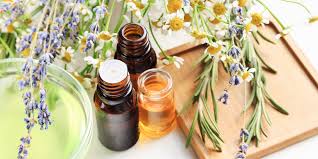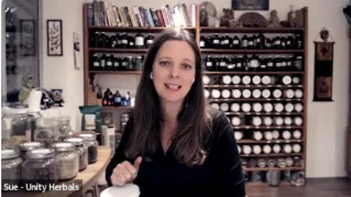The healing power of external applications with Susan Horning, CHT
Watch this presentation on Youtube!
There’s so many ways to use plants to enhance health and wellbeing. Topical applications are an effective and safe way to absorb herbs through the skin and deliver effective relief for many conditions.
Not just for skin conditions, topical applications are a very safe way to deliver herbs to localized areas of the body without requiring digestion or assimilation through the gut, which is helpful in situations where internal use may not be safe or optimal.
Different herbal preparations to consider:
Herbal Infused oil – Herbs infused directly to carrier oil, with or without ethanol extraction
Salve – Infused oil hardened with beeswax
Cream – Water-based preparation, most viscous and easily spread on larger areas
Ointment – Oil-based preparation, will hold more moisture on dry skin
Lotion – Least amount of oil, and are lighter in application than creams/ointments
Liniment – Mix of tincture and oil and essential oils, must be shaken before application
Poultice – Macerated plant material applied directly to skin
Honey – Great for burns with infused soothing plants
Fomentation – Facecloth soaked in herbal infusion or saline solution (usually hot/warm)
Hydrosol – Distilled plant waters
Spray – Distilled water or hydrosol with essential oils and/or carrier oils and/or tincture
Toothpaste – Paste of powdered plant material with essential oils and/or carrier oils
Dusting powder – Dry powder for sprinkling on wet or weeping wounds
Deodorant – Paste of plants with baking soda, arrowroot, oils, clay, besswax, etc.
Hair rinse – Vinegar extraction with oil
Sits bath – Herbal infusion added to saline solution
Bath soak – Herbal infusion added to magnesium salts with essential oils and/or carrier oils
Some of my favourite herbs to use topically:
Usnea
Calendula officinalis, Symphytum officinale (vulnerary and tissue repair)
Capscium minimum, Zingiber officinalis (for pain, to heal blisters, and to boost local circulation)
Galium aparine, Trifolium pratense, Phytolacca decandra (for lymphatic drainage and clearing out waste cells)
Mentha-X piperita (to cool and allay irritation)
Matricaria recuitita, Achillea millefolium, Usnea (for inflammation or fungal infections)
Hamamelis virginica, Thuja officinalis (to astringe or dry out pus)
Stellaria media (for pruritis)
Berberis aquifolium, Echinacea angustifolium , Curcuma longa (to heal boils or infections)
Glychyrriza glabra, Althaea officinalis (demulcent, soothing, emollient)
Aesculus hippocastanum (for vascular tone)
Good choices for oil extraction include olive oil, jojoba, grape seed, castor, sunflower, safflower, flax, avocado, etc. However oil is generally not a very good solvent, so an intermediary step is often helpful. Fresh herbs should be used with caution – mould and bacteria in water-based preparations are common and establishing expiry dates, refrigeration and use of emulsifiers may be necessary.
ENDOGENOUS FACTORS in healing skin, systemic support
- Centella asiatica and Vitamin C, Zinc, Vitamin D supplementation are primary
- Linolenic acid is often deficient with eczema and EFA supplementation (sunflower, safflower, flax seed oil) in the diet will help, or can also be applied topically
- Improving lymphatic, renal and colonic functions with Fumaria officionalis, Scrophularia, Rumex and Berberis can be helpful for systemic support.
- Nervous system support to allay anxiety may also support skin healing, Valeriana officinalis, Passiflora incarnata, Hypericum perfoliatum, Humulus lupulus, Scutellaria lateriflora may be helpful if there are psychological factors present.
- Where allergies are primary, Urtica dioica and Aspalanthus linearis may be used as antihistaminic.
EXOGENOUS FACTORS in healing skin
- Contact dermatitis is a rash resulting from exposure to an allergen, chemical or other exogenous irritant. Chemicals are more readily absorbed in contact with moisture so the sweating areas of the body are more affected.
- Stasis dermatitis is associated with venous insufficiency, and is more common in elderly women, and may require boosting circulation and consideration of other chronic disease considerations
- Irritant dermatitis might be due to nickel or chromates found in jewelry, rubber and elastics, dyes in clothing, hair and shoes, cosmetics, leather (chemicals), plants, and exposure to chemicals is often found on the hands that have come in to contact with the irritant. Identifying and avoiding the irritant is of primary importance in treatment.
- Tinea is usually circular spreading from a centre point (sometimes called ‘ringworm’) and it is a fungal infection that is scaly, red with elevated borders. It invades keratinous tissue and causes inflammation
- Avoiding irritants to the skin and use mild soap (or avoid soap completely) only without scents where needed and avoid hot water showers. Lubricants can be used to restore moisture to the surface of the skin, being careful of ingredients such as lanolin, which may irritate further.






